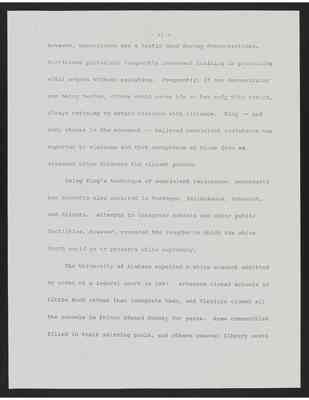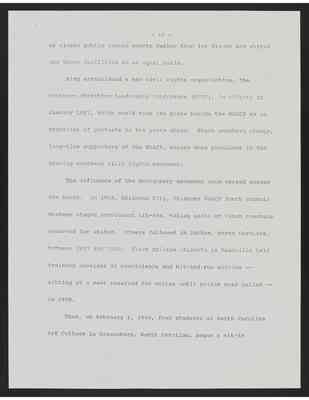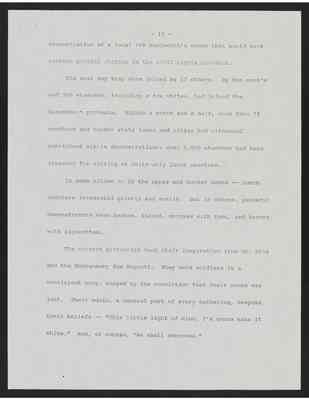Pages
11
however, nonviolence was a tactic used during demonstrations. Nonviolent protestors frequently underwent training in protecting vital organs without resisting. Frequently, if one demonstrator was being beaten, others would cover his or her body with theirs, always refusing to return violence with violence. King -- and many others in the movement -- believed nonviolent resistance was superior to violence and that acceptance of blows from an attacker often disarmed the violent person.
Using King's technique of nonviolent resistance, successful bus boycotts also occurred in Tuskegee, Tallahassee, Savannah, and Atlanta. Attempts to integrate schools and other public facilities, however, revealed the lengths to which the white South would go to preserve white supremacy.
The University of Alabama expelled a white student admitted by order of a federal court in 1957. Arkansas closed schools in Little Rock rather than integrate them, and Virginia closed all the schools in Prince Edward County for years. Some communities filled in their swimming pools, and others removed library seats
12
or closed public tennis courts rather than let Blacks and whites use these facilities on an equal basis.
King established a new civil rights organization, the Southern Christian Leadership Conference (SCLC), in Atlanta in January 1957, which would take its place beside the NAACP as an organizer of protests in the years ahead. Black southern clergy, long-time supporters of the NCCAP, became more prominent in the growing southern civil rights movement.
The influence of the Montgomery movement soon spread across the South. In 1958, Oklahoma City, Oklahoma NAACP Youth Council Members staged nonviolent sit-ins, taking seats at lunch counters reserved for whites. Others followed in Durham, North Carolina, between 1957 and 1960. Black college students in Nashville held training sessions in nonviolence and hit-and-run sit-ins -- sitting at a seat reserved for whites until police were called -- in 1959.
Then, on February 1, 1960, four students at North Carolina A&T College in Greensboro, North Carolina, began a sit-in
13
demonstration at a local F&W Woolworth's store that would mark another pivotal chapter in the civil rights movement.
The next day they were joined by 27 others. By the week's end 300 students, including a few whites, had joined the Greensboro protests. Within a month and a half, more than 75 southern and border state towns and cities had witnessed nonviolent sit-in demonstrations; over 2,000 students had been arrested for sitting at white-only lunch counters.
In some cities -- in the upper and border South -- lunc counters integrated quietly and easily. But in others, peaceful demonstrators were beaten, kicked, sprayed with food, and burned with cigarettes.
The student protestors took their inspiration from Dr. King and the Montgomery Bus Boycott. They were soldiers in a nonviolent army, buoyed by the conviction that their cause was just. Their music, a central part of every gathering, bespoke their beliefs -- "This little light of mine, I'm gonna make it shine." And, of course, "We shall overcome."
14
On Easter weekend, 1960, representatives from student sit-in groups around the country met in Raleigh, North Carolina, to form the Student Nonviolent Coordinating Committee (SNCC). Resisting attempts by older civil rights organizations to become "youth chapters" of the established groups, they opted for independence.
The lunch counter sit-ins ended in late 1961 with most upper South communities integrating their lunch counters. Resistance remained strongest in the deep South, where students had met violence, and some had been expelled from school. The deep South became the next battleground between nonviolent demonstrators and violent segregationists.
On May 4, 1961, two groups of integrated bus riders, sponsored by the Congress of Racial Equality (CORE), left Washington, D. C.
In December 1960, the United States Supreme Court had ordered an end to segregation on interstate buses and trains. CORE's "Freedom Ride" would test whether this order was being obeyed.
15
After writing President John F. Kennedy, Attorney General Robert Kennedy, and Director of the Federal Bureau of Investigation J. Edgar Hoover of their plans, the Riders left the nation's capital and headed south.
They encountered little trouble until Mother's Day, May 14, when a mob attacked the Riders on a Greyhound bus outside Anniston, Alabama, burning the bus and beating several of the riders brutally. When the other Riders, on a Trailways bus, arrived at the Anniston station an hour later, a mob of whites boarded the bus and beat the occupants from the front to the rear. One Rider suffered permanent brain damage.
As the bloodied Riders stepped from their Trailways bus in Birmingham, there was not a policeman in sight. For ten minutes, a wild mob was allowed to beat the nonviolent Riders. One needed 53 stitches to close his wounds.
Undaunted, the Freedom Riders decided to continue, but no bus company employee would drive them. The United States Department of Justice arranged for the Riders to leave Birmingham




